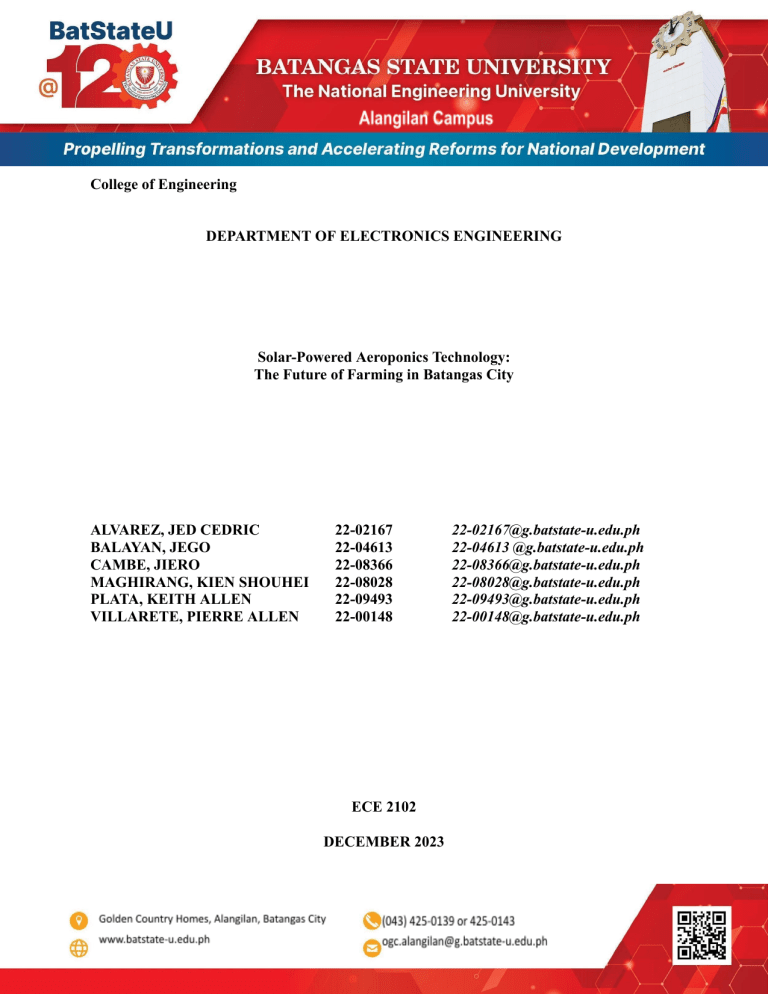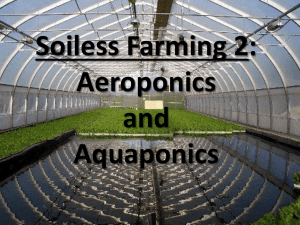
College of Engineering DEPARTMENT OF ELECTRONICS ENGINEERING Solar-Powered Aeroponics Technology: The Future of Farming in Batangas City ALVAREZ, JED CEDRIC BALAYAN, JEGO CAMBE, JIERO MAGHIRANG, KIEN SHOUHEI PLATA, KEITH ALLEN VILLARETE, PIERRE ALLEN 22-02167 22-04613 22-08366 22-08028 22-09493 22-00148 ECE 2102 DECEMBER 2023 22-02167@g.batstate-u.edu.ph 22-04613 @g.batstate-u.edu.ph 22-08366@g.batstate-u.edu.ph 22-08028@g.batstate-u.edu.ph 22-09493@g.batstate-u.edu.ph 22-00148@g.batstate-u.edu.ph College of Engineering I. Introduction Aeroponics is a method of growing plants without soil, where plant roots are suspended in an air or mist environment and receive nutrients through a fine mist solution. This technique allows for efficient water usage and faster growth rates compared to traditional soil-based methods. Integrating solar power into aeroponics systems involves using solar panels to harness energy from sunlight. This energy can be used to power pumps, lights, or other components essential for the aeroponic system. By utilizing solar energy, these systems can operate off-grid or reduce their reliance on conventional power sources, making them more sustainable and environmentally friendly. Aeroponics is a soilless method that creates a controlled environment for plant growth using air and a nutrient-rich mist. It's highly efficient, requiring significantly less water than traditional farming methods and even surpassing the water-saving capabilities of hydroponics. Plants grown aeroponically exhibit increased uptake of minerals and vitamins, potentially enhancing their nutritional value. According to Kumari & Kumar (2019). This system ensures plants receive optimal oxygen and carbon dioxide, stimulating rapid growth and reducing the time needed for root establishment. It's not limited to specific types of plants; any species can thrive in aeroponics due to its finely controllable micro-environment. Moreover, aeroponics allows for higher planting densities as competition for nutrients and water among plants is minimized. It has various applications, including efficient seed production, pharmaceutical bio-pharming within plants, and improved cloning outcomes by enhancing root growth and maturation. Studies have consistently shown superior yields in crops grown via aeroponics compared to conventional methods, attributing this to increased leaf functions and overall efficiency in photosynthesis. College of Engineering Through the study of Grazon & Montes (2023). Aeroponics, a soil-free plant cultivation method, involves suspending roots in air and showering them with a nutrient-rich water solution via pumps and spray nozzles. This process delivers oxygenated mist at intervals, enabling roots to absorb essential nutrients and water. Compared to traditional soil-based farming, aeroponics boasts faster growth, increased yields, and resource efficiency. Its soil-free setup minimizes disease and pest risks, promoting sustainability. However, challenges like setup costs, maintenance, and technical expertise are notable. Although relatively new, aeroponics has proven effective for various crops like lettuce, tomatoes, and strawberries. Technological advancements allow year-round cultivation by manipulating environmental factors such as humidity, temperature, airflow, and light intensity using specialized tools and systems. Based on the study by Miller (2018). A new-age farming practice called aeroponics can make a large impact in impoverished communities due to its resource-conserving practices and high output potential. Aeroponics is a soilless model that utilizes a sprayer system to apply nutrient-rich water to a suspended root structure. Aeroponics differs from its sister methods, aquaponics, and hydroponics, by growing root systems without direct contact with water. The applied spray is concentrated with essential macro- and micronutrients, typically provided from purchased chemicals but does not require pesticides. Producers can control the entire growing environment by keeping the setup in an enclosed space and climate-controlled. II. Summary In the face of agricultural decline due to various factors, including natural disasters and the eruption of Taal Volcano, a beacon of hope emerges in the form of Solar-Powered Aeroponics Technology. This innovative approach aims to revitalize crop yields and College of Engineering restore the agricultural prosperity of Batangas City. Solar-Powered Aeroponics Technology offers a transformative solution to these pressing issues. This cutting-edge system employs a soilless growing method that utilizes nutrient-rich mist to nourish plants, optimizing resource utilization and minimizing environmental impact. III. Agricultural Decline Affected commodities include rice, corn coffee, coconut, cacao, banana, pineapple, and other fruits and valuable crops. Retrieved from The Philippine Star (2020), The image shows the effects of the eruption of Taal Volcano in January of 2020 which unleashed a torrent of ash and debris upon the surrounding countryside, causing widespread damage to agriculture in Batangas, Philippines. College of Engineering The volcanic material wreaked havoc on crops, contaminating soil and rendering vast swathes of land unproductive. The volcanic material wreaked havoc on crops, contaminating soil and rendering vast swathes of land unproductive. The overall impact was staggering, with agricultural losses estimated at a staggering 3.2 billion pesos (Simeon, 2020). The eruption's immediate impact on crops was particularly severe. The volcanic ash blocked sunlight, preventing crops from photosynthesizing and leading to widespread crop failures. The debris, heavy and abrasive, damaged crops by crushing stems and tearing leaves. Rice, corn, vegetables, and fruits were among the most affected crops. In the towns of Calatagan, Talisay, and Taal, which bore the brunt of the eruption's fury, crop yields plummeted by as much as 90%. In addition to the immediate damage to crops, the eruption of Taal Volcano also had a long-term impact on soil quality in Batangas. The volcanic ash and debris that fell on the land lead to elevated soil sulfur levels and lowered soil pH. These changes in soil composition can reduce the availability of phosphate and other essential minerals and alter the soil's characteristics to such an extent that arable crops and pasture plants will not survive. The ash also contained heavy metals that can be toxic to plants making it less suitable for plant growth. The decline in soil quality has made it difficult for farmers to grow crops. Many farmers have reported that their yields have decreased significantly since the eruption. In some cases, farmers have been forced to abandon their land altogether. The economic repercussions of the eruption were far-reaching. Batangas, a region heavily reliant on agriculture, experienced a decline in agricultural output. This decline led to job losses and a decrease in income for farmers, exacerbating existing poverty and economic hardship. The eruption's ripple effects extended beyond the agricultural sector, impacting businesses that relied on agriculture for their operations. College of Engineering Agriculture Sercretary William Dar’s visit in Batangas and Cavite last year on January 18, where thousand of farmers, fishers, ruralfolk, and residents were adversely affected with the eruption of Taal Volcano. (photoRTDC/DA StratComms) In the aftermath of the eruption, the Philippine government stepped in to provide financial assistance to affected farmers. Additionally, programs aimed at improving soil quality and promoting sustainable agricultural practices were implemented. While these measures provided much-needed support, the road to recovery for Batangas agriculture remains long and arduous. The long-term impact of the eruption on soil quality is still being assessed, and the full extent of the economic damage may not be known for years. Despite these challenges, there is a glimmer of hope. Farmers and researchers are working together to develop innovative agricultural practices that can restore productivity to the affected lands. The journey to rebuild Batangas agriculture will be arduous, but it is a testament to the resilience of the human spirit and the unwavering determination of the Filipino people. College of Engineering IV. Green Urban Initiative Green initiatives seek to preserve and improve the environment through the use of sustainable, eco-friendly, and environmentally safe practices and alternatives. This includes efforts to reduce pollution and waste, conserve resources, and maintain an ecological balance by: 1. Energy conservation or a shift to renewable energy 2. Using biodegradable or reusable/recyclable products or reducing waste 3. Using locally sourced materials or environmentally friendly delivery methods Economic Benefits of Green Initiatives Going green can significantly reduce costs and save money on energy and water consumption. It may also result in tax breaks. Using renewable energy or recycling water can lower utility bills, while recycling materials can lower production costs. Furthermore, by employing greener, non-toxic practices, businesses may reduce the amount spent on employee healthcare while also increasing employee morale. As the trend toward environmentally conscious living grows, "green" businesses have proven to be more profitable. This is because customers actively seek out goods and services from companies that have clear environmental initiatives. Health Benefits of Green Initiatives Green initiatives can help to reduce pollution in the air, water, and soil, all of which are important for a community's overall health. Toxins entering the body are significantly reduced when pollutants in the environment are reduced. This can improve health and reduce mortality. Air pollution can cause respiratory problems, polluted soil can harm crops, and contaminated water can spread diseases. Reducing pollution through green initiatives is thus a solution for improving the health of the general population. College of Engineering Environmental Benefits of Green Initiatives Green initiatives benefit the environment by lowering pollution and carbon emissions that deplete the ozone layer. Simple measures also promote the overall health of a region's flora and fauna, resulting in a more sustainable and secure future for future generations. Given the significance of green initiatives and the impact of the healthcare industry on the environment, it is critical to understand how concrete improvements can be made in this sector. Green Urban Initiatives in Batangas Batangas is endowed with a diverse plant and animal life, as well as natural wonders such as mountains, oceans, falls, creeks, forests, and rivers. In addition, the province of Batangas has a total land area of 316,581 hectares. Rich fertile land, favorable weather, and a diverse landscape justify the vast agricultural base. Sugarcane, rice, corn, vegetables, fruits, and root crops are among the traditional crops grown in the province. The topography is almost entirely made up of highlands, rolling terrain, small low flat lands, and a few mountains. Despite the abundance of natural resources and the beauty of the environment, it faces problems or threats that can destroy our nature, such as calamities and others. Floods, typhoons, urban fires, oil and chemical spillage, sea tragedies, lightning, and landslides are the most common hazards in the city. Its vulnerability to hazards can be attributed to its topography, which includes mountainous, coastal, and island barangays. As a result, the Batangas government took action to provide a solution to the problems that have been and will be faced in daily life regarding the state of the environment. College of Engineering Batangas City maintains its reputation as a very livable and happy community. The harmony between diverse economic activity and environmental protection, which has been a thrust and continuously promoted by leaders, has always been evident in every effort of the local government. Indeed, Batangas City's local leaders stated that the city aims to be the first carbon-neutral city in the Philippines by 2030 and has developed a comprehensive climate mitigation and adaptation plan, Baretto (2021), to achieve this goal. Furthermore, incentives are offered for green initiatives. The local government of Batangas City recognizes that their environmental sustainability objectives can only be met through unified action among its communities. People must work together with leaders to advance efforts to protect and conserve natural resources. As a result, there are several incentives available to those who have green initiatives. Furthermore, according to Alarzar et al. (2018), different environmental laws and practices have been implemented in various areas of Batangas. These include the anti-plastic ordinance, 5S, coastal cleanup, solid waste management, and reduce, reuse, and recycle initiatives. These are practices that allow us to safeguard our environment. Finally, the preservation of Batangas City's image through the preservation of natural resources or pushing to do what needs to be done regarding the environment, such as green initiatives programs, will continue. As a result, the region will retain its reputation as one of the richest in terms of natural resources. V. Proposal of Solar-Powered Aeroponics Technology In the ever-evolving landscape of agricultural practices, technology plays a pivotal role in revolutionizing traditional methods and enhancing efficiency. According to Garzon (2023), Aeroponics is a soilless agricultural technique that grows plants by misting their roots with a nutrient-rich solution. Unlike conventional soil-based or hydroponic systems, aeroponics relies on the suspension of plants in an air or mist environment, delivering College of Engineering essential nutrients directly to the roots. When combined with electronic systems, this innovative approach offers precise control over environmental variables, ensuring optimal conditions for plant development. Lettus Grow’s lead project Engineer Temi Odanye (right) with electronics engineer Adam Manuel and a crop of microgreens frown on the company’s rolling bench. Retrieved from Hort News (2023), the image above shows the crop yielded through aeroponics technology by Engineers Temi Odanye and Adam Manuel. In conventional hydroponic or nutrient film technique (NFT) systems, plant roots are immersed in a nutrient solution. In aeroponics, however, the roots are elevated in the air and subjected to a fine mist. Lettuce Grow contends that this method enhances oxygenation, leading to improved plant growth and substantial crop yield boosts ranging from 20% to 200% compared to hydroponics. College of Engineering Figure 1. Vipul Shinde’s Visual Design of Aeroponics System Figure 1 above shows the stock design for Aeroponics System consisting of a pump and nozzle selection, a nutrient pump, storage of water and nutrients, a timer, and a reservoir. While this design is considered mobile with less maintenance, this study aims to incorporate an environmental sensor for humidity and temperature, smart light system for accurate light distribution among crops, and solar panels for overall efficiency. When combined with electronic systems, this innovative approach offers precise control over environmental variables, ensuring optimal conditions for plant development. The proposal of a solar-powered aeroponics technology leverages sensors, actuators, and intelligent control systems to monitor and regulate factors such as temperature, humidity, nutrient concentration, and lighting. This level of automation allows for a highly customizable and adaptive cultivation environment, catering to the specific needs of different plant species. The integration of electronics not only streamlines the cultivation College of Engineering process but also minimizes resource usage, making it a sustainable and eco-friendly alternative to traditional farming methods. Integration of Respberry Pi and humidity sensors on aeroponics system by wcammoths in Circuits Retrieved from AutoDesk Instructables (2022), the image above shows the final output of an aeroponics system with humidity sensors hidden beneath the reservoir. The aim of this proposal is to continue to explore the potential of Electronics Aeroponics and extend its impact on agriculture beyond traditional farming boundaries, ushering in a new era of smart, efficient, and environmentally conscious cultivation methods. College of Engineering VI. Conclusion In conclusion, the challenges faced by Batangas City in recent years, particularly in agriculture, have been exacerbated by natural calamities such as the Taal Volcano eruption. The aftermath of the eruption has significantly impacted soil quality, leading to decreased crop yields and forcing some farmers to abandon their land. Recognizing the need for a sustainable solution, this study aims to propose the implementation of aeroponics as an innovative approach. Unlike traditional farming methods, aeroponics doesn't rely on compromised soil conditions, making it a viable solution for Batangas City's agricultural woes. By adopting aeroponics, not only can the negative effects of volcanic damage be mitigated, but it also offers a practical solution for areas with limited space. In essence, aeroponics stands as a promising means to address the agricultural challenges faced by Batangas City, offering a pathway towards enhanced productivity and resilience in the face of adversity. VII. References Alarzar, D., Briones, L.M., Canlas, N.J., & Magnaye, B. (2018). Environmental Practices of Batanguenos as Input to Model Development. Asia Pacific Journal of Education, Arts and Sciences, Vol. 5 No. 4. Retrieved from https://apjeas.apjmr.com/wp-content/uploads/2019/08/APJEAS-2018.5.4.08.pdf?f bclid=IwAR33RsN_PzrEFXdtTgiVPk4iT-S4IQmM0Ge3Zvi5cmXwERAcQ4x LVOQUl Barretto, A. (2021). The Environmental Sustainability of Batangas City. Pueblo De Oro Development Corporation. Retrieved from https://pueblodeoro.com/blog/environmental-sustainability-batangas-city/?fbclid IwAR2GFatRyigf7z3yA_IV7q7-byphlfaivjNDI2vmWTYsxjtMZQ5ArZEtHNU# ~:text=Batangas%20City%20is%20blessed%20with,creeks%2C%20forests%2 College of Engineering %20and%20rivers Francis, F., Vishnu, P. L., Jha, M., & Ragaram, B. (2018). IOT-Based Automated Aeroponics System. In Intelligent Embedded Systems (pp.337-345). Retrieved from IOT-Based Automated Aeroponics System | SpringerLink Garzon, J., Montes L,. & Lampropoulos, G. (2023). Systematic Review of Technology in Aeroponics: Introducing the Technology Adoption and Integration in Sustainable Agriculture Model. Retrieved from Agronomy | Free Full-Text | Systematic Review of Technology in Aeroponics: Introducing the Technology Adoption and Integration in Sustainable Agriculture Model (mdpi.com) Kumari, R., & Kumar, R. (2019). Aeroponics: A Review on Modern Agriculture Technology. Retrieved from https://www.researchgate.net/publication/342804239_Aeroponics_A_Review_o _Modern_Agriculture_Technology?fbclid=IwAR0aSbmZBNAyOImZAGc4Vp4gz53EV6mu37t5dF2AuMu2RMNEmYuCen2dI Lakhiar, I.A., Gao, J. Syed, T., Chandio, F.A.& Buttar, N.A. (2018). Modern plant cultivation technologies in agriculture under controlled environment: A Review on Aeroponics. Retrieved from (PDF) Modern plant cultivation technologies in agriculture under controlled environment: A review on aeroponics (researchgate.net) Manuel, A. & Odanye, T. (2023). Growers sought trials of aeroponics. Hort News. Retrieved from https://hortnews.com/growers-sought-for-trials-of-aeroponics/ Miller, M. (2018). Aeroponics: A Sustainable Solution for Urban Agriculture. Retrieved from https://www.eli.org/vibrant-environment-blog/aeroponics-sustain able-solution-urba-agriculture?fbclid=IwAR1UzIpmjLuATK_EpiEjfSjVxgrYyE8 pjE_C0Wjxvq8BkYWl8H0FFFzlqZ Philippine Department of Agriculture (DA). (2020). Taal Volcano Eruption Damages College of Engineering Agriculture Worth P3.17 Billion. Retrieved from https://www.pna.gov.ph/articles/1090839. Simeon, L. M. (2020, January 20). Taal damage to agri hits P3.2 B. The Philippine Star, p. 14. Retrieved from http://hdl.handle.net/20.500.12174/7903 The Future of Innovation is Now: Aeroponics Farming. (2023, October 22).Retrieved from https://redgreenandblue.org/2020/09/10/aeroponics-make-agriculturesustainable/ Wcammoths. (2022). Aeroponics With Raspberry Pi and Humidity Sensor. Autodesk Instructables. Retrieved from https://www.instructables.com/Aeroponics/ What is Aeroponics, and how could it make agriculture more sustainable. (2020, September 10). Retrieved from https://redgreenandblue.org/2020/09/10/aeroponic -make-agriculture-sustainable/ World-leading aeroponics. World-changing potential. Grow more food, more sustainably, in vertical farms & greenhouses(2023).Retrievedfrom https://www.le ttusgrow.com/aeroponic-technology?fbclid=IwAR17XLKKAdKlI-QqDXnTL0i dGa-CvocpCLH7H4TomEHh8WEewXIGPZyCwc Yamasaki, M., & Takeuchi, K. (2002). Volcanic ash: A major source of nutrient for acidified soils. Journal of Volcanology and Geothermal Research, 116(1-2), 121-133. Retrieved from https://volcanoes.usgs.gov/volcanic_ash/ash_comp osition_pastures. (2018). Automated Aeroponics System for Indoor Farming using Arduino. In 2018 Joint 7th International Conference on Informatics, Electronics & Vision (ICIEV) and 2018 2nd International Conference on Imaging, Vision & Pattern Recognition (icIVPR). Retrieved from Automated Aeroponics System for Indoor Farming using Arduino | IEEE Conference Publication | IEEE Xplore (n.d.). Automated aeroponics vegetable growing system. Case study Lettuce. IEEE College of Engineering Xplore Retrieved from Automated aeroponics vegetable growing system. Case study Lettuce | IEEE Conference Publication | IEEE Xplore (n.d.). Systematic Review of Technology in Aeroponics: Introducing the Technology Adoption and Integration in Sustainable Agriculture Model. MDPI Retrieved from Agronomy | Free Full-Text | Systematic Review of Technology in Aeroponics: Introducing the Technology Adoption and Integration in Sustainable Agriculture Model (mdpi.com) (n.d.). IOT-Based Automated Aeroponics System. Retrieved from IOT-Based Automated Aeroponics System | SpringerLink (n.d.). Aeroponic System Optimization for Future Sustainability. Scholarly Commons. Retrieved from Scholarly Commons - Student Research Symposium (SRS)




